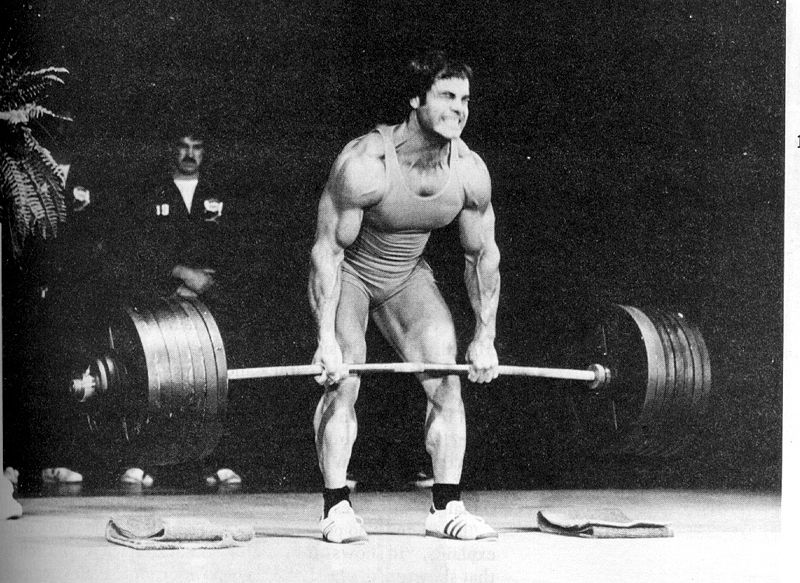More than anything else, George Butler and Charles Gaines’ 1977 pseudo-documentary, Pumping Iron, brought the appeal of muscle mass to America. A loose look inside the world of competitive bodybuilding starring a charismatic if Machiavellian Arnold Schwarzenegger, the film focused on Gold’s Gym in Venice Beach, which was ground zero for bicep building and steroid taking in the U.S. The original Gold’s is the focus of Paul Solotaroff’s new Men’s Journal article, “Muscle Beach and the Dawn of Huge.” The opening:
“Robby Robinson, a wedge of black marble, arrived in Venice Beach in 1975 with one oversize suitcase and seven dollars. That was every dime he had after quitting his job and selling everything of value but the trophies he’d won at bodybuilding shows in the Jim Crow South. He’d left behind a wife, three small children, and a certain localized fame as the best-ever body in the state of Florida, fronting 20-inch biceps, a 28-inch waist, and 205 pounds of peaked, freak muscle on his hourglass, 5-foot-8 frame. But if your dream back then was to make the cover of Muscle Builder and storm the palace of giants in your sport, there was one thing to do and one place to do it: Join Gold’s Gym in Venice Beach. With the ocean at its back, the sun through its skylights, and the biggest men on Earth trooping in by the dozen to bench 450 before breakfast, Gold’s was Camelot-by-the-shore. You felt its pull in your hypertrophied heart, deep in the belly of that reckless muscle.
Robinson, born and raised in the swamps of Tallahassee by an illiterate mother and a bootlegging father who later abandoned his 14 children, had a deep and perfectly rational terror of whites. Driving to shows in Mississippi and Georgia, he had seen the signs posted on rural light poles: niggers, don’t get caught here come sundown. But it was a letter from a white man that had brought him to Venice: a written invitation from no less than Joe Weider, the publisher of Muscle Builder, to come out and join his stable of champion bodies living and training large in Los Angeles. Robinson got off the plane expecting to be met by Weider, or if not by him then by Arnold Schwarzenegger, Weider’s Austrian prince, who’d won the title of Mr. Olympia five times running. Neither showed up, though, and after standing around for hours, Robinson tossed the suitcase over his shoulder and walked nine miles to Venice in platform heels.
He found a place to crash at a fellow bodybuilder’s and showed up at Gold’s one morning that spring, gawking through the window, dumbstruck. ‘I couldn’t bring myself to train. I was so in awe. All my idols in one room! Arnold and Denny Gable, Bob Birdsong and Franco Columbu; these beasts working out with no shirts or shoes and a crowd of people watching from the street.’ The gym manager, Ken Waller (a Mr. America and Mr. Universe), saw Robinson hulking by the door. ‘You,’ he growled. ‘You wanna train here? Fine: Come lift what we lift.’ He pointed to a pair of humongous dumbbells, 150-pounders with tapered grips. ‘Get down on that bench and give me 10,’ he said. ‘Otherwise, get the fuck out and stay out.’ Robinson, who’d built himself in backwoods gyms, had never seen dumbbells half so big. Somehow he got them onto his thighs, then, trembling, winched his back down on the bench. Each rep was a carnival of toil and pain, the weights teetering as they went up and ticked back down, the fibers of his mid-pecs shrieking. ‘I’ve no idea how I did that set,’ says Robinson, now 65 and still wondrously carved, his traps and triceps bulking through a linen shirt, his waistline waspish as ever. ‘But the adrenaline going through me then, that drive to be one of them — it was like a double shot of steroids and B-12.’ He fought the 10th rep up, screaming and twisting, then dropped the weights on the concrete floor. ‘You’re in,’ grunted Waller. ‘You’re one of us. Now go and give me a dead lift of 700.'”
••••••••••
“Can you believe how much I am in heaven?”

